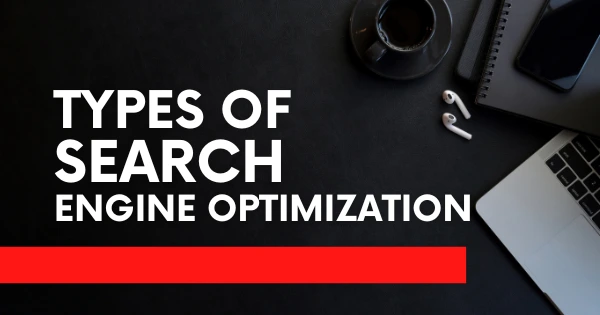Most of us are familiar with SEO – or search engine optimization – but few people know what it means.
When it comes to SEO, there are many different types of SEO that you can choose from, so how do you know which one is right for your website?

Here are 10 types of SEO that you may consider when creating a new website or updating an existing one.
What is SEO?

Search Engine Optimization (SEO) is a system of techniques that allows your website to be found by search engines. The goal of SEO is to optimize the page on your website so that it appears higher in the search results than on other pages.
List of 10 Types of SEO
There are many ten types of SEO, including:
- On-page SEO
- Off-page SEO
- Technical SEO
- YouTube SEO
- Local SEO
- Enterprise SEO
- White Hat SEO
- Black Hat SEO
- Grey Hat SEO
- Negative SEO
- Mobile SEO
- E-commerce SEO
- Voice Search SEO
- Video SEO
- Image SEO
- International SEO
On page SEO
On-page SEO is optimizing web pages to a higher rank in search results. It refers to on-site optimization that you control and includes within the website.
Here are some on-page SEO techniques;
- Long tail keywords for better rankings
- Title tags and meta descriptions are optimized
- In primary keywords, short URLs include
- High-quality content
- At least one to two keywords in every blog post
- ALT tags to images
- Internal linking
Off-page SEO
Off-page SEO is optimizing a website for better search engine rankings by building links, improving social media engagement, and increasing brand awareness.
Here are some off-page SEO techniques;
- Link building
- Social networking
- Blog commenting
- Social bookmarking
- Forum Posting
- Influencer outreach
- Guest posting
- Write helpful answers on platforms such as Quora to build links
Technical SEO
It is the process of optimizing a website for search engines. It involves improving the website’s architecture, code, and content so that the search engines can crawl and index the site more effectively.

Here are some techniques;
- Fix all the missing ALT tags, lengthy meta descriptions, missing titles, etc.
- It can also involve optimizing the server
- Network infrastructure to improve site performance.
- Find and fix all the broken links on your website
- Find all the toxic links that are pointing to your site
- Crawl your site and look for any crawl errors
- Get rid of duplicate and thin content
- The site should be crawlable and indexable
- Ensure your site is equipped with HTTPS
- The website should be mobile-friendly
YouTube SEO
YouTube is the second largest search engine, so ensuring your videos are properly optimized for both YouTube and Google searches is essential.
Here are some tips for optimizing your YouTube videos:
- Use keyword-rich titles
- Use tags
- Optimize your thumbnail image
- Use transcripts
- Promote your videos
Local SEO
As a small business, ensuring your website is optimized for local searches is essential. This means ensuring your website is visible when people search for businesses like yours.
Some of the local SEO tactics are;
- Local SEO involves optimizing your website for specific keywords related to your business.
- Ensure your website is listed in local directories and map-based search engines.
- You can ensure your website is more visible to potential customers in your area, leading to more traffic and business.
- Optimizing your Google My Business profile
Enterprise SEO
Enterprise SEO is a set of optimization strategies and techniques used to improve the visibility and ranking of a website in search engine results pages (SERPs). It is a specialized form of SEO designed to meet large organizations’ unique needs.
Some of the enterprise SEO techniques are;
- Targeted competitive keywords
- Optimizing your content
- Competing with authority and big websites
- High-quality content produced regularly
- Using structural data
White Hat SEO
White hat SEO is a set of best practices that focus on providing a great user experience while also helping improve your search engine ranking.
These practices include things;
- Creating well-written
- Keyword-rich content
- Optimizing your website for speed, mobile friendliness
- Building high-quality backlinks
- While it may take a bit more time and effort to implement white-hat SEO tactics, the long-term benefits are worth it
- Not only will you see a boost in your search engine ranking, but you’ll also acquire more loyal and engaged customers.
Black Hat SEO
Black hat SEO is a term used to describe a range of unethical and manipulative practices used to improve a website’s search engine ranking.
These practices go against the guidelines set out by search engines and can result in penalties or even getting banned from the search engine altogether.
Some familiar black hat SEO practices include;
- Keyword stuffing
- link buying, and cloaking.
- Cloaking
- Use of hidden links
- Spam comments
- Copied content
Grey Hat SEO
There is no definitive answer as to what Grey Hat SEO is. Some say it combines Black Hat and White Hat SEO techniques, while others say it is a type of SEO that falls between them.
Grey Hat SEO is often seen as a more risky approach than White Hat SEO. As a result of penalties from search engines if done improperly.
Grey Hat SEO can also be very effective if done correctly and can help a website rank higher in search results.
It includes;
- Buying domains with exactly matching keywords
- Buying expire domains
- Buying links
- Purchasing followers to grow online
Negative SEO
Negative SEO is an online attack that harms a website’s reputation and ranking. It involves using black hat techniques to create false or negative information about a website to lower its search engine ranking.
This is done by creating fake reviews, spreading negative rumours, or using other underhanded tactics. Negative SEO can be difficult to detect and seriously impact a website’s business.
Here are some negative SEO tactics;
- Spammy link building
- Fake reviews about a product
- scraped content
- Link farms
- Hacking a website
Mobile SEO
With the increasing use of smartphones and mobile devices, mobile SEO has become paramount. Mobile SEO ensures a website is optimized for mobile users, providing a seamless browsing experience on smaller screens. This includes responsive web design, mobile-friendly layouts, fast loading times, and voice search optimization. Mobile SEO helps businesses reach and engage with growing mobile internet users.
E-commerce SEO
E-commerce SEO optimizes online stores to attract organic traffic and increase sales. It includes optimizing product descriptions, implementing structured data markup, improving website navigation, and optimizing for relevant keywords. E-commerce SEO helps businesses stand out in a highly competitive online marketplace and improve their visibility among potential customers searching for products.
Voice Search SEO
As voice assistants like Siri, Alexa, and Google Assistant gain popularity, optimizing for voice search has become essential. Voice search SEO involves optimizing content to align with natural language queries and conversational search patterns. It includes using long-tail keywords, providing concise answers, and structuring content in a question-and-answer format. Voice search SEO helps businesses capture voice search traffic and enhance user experience.
Video SEO
Video content has become increasingly popular, and video SEO aims to optimize videos for better visibility in search results. This includes optimizing video titles, descriptions, tags, and transcripts. Video SEO also involves hosting videos on platforms like YouTube and optimizing them for specific keywords and topics. By implementing video SEO techniques, businesses can increase their chances of appearing in video search results and attract a wider audience.
Image SEO
Image SEO focuses on optimizing images to improve their visibility in image search results and enhance overall website performance. This includes using descriptive filenames, alt tags, and captions, optimizing image sizes for faster loading, and ensuring images are relevant to the website’s content. Image SEO helps businesses drive additional organic traffic by appearing in image search results and improving user experience.
International SEO
International SEO is vital for businesses operating in multiple countries or targeting an international audience. It involves optimizing websites to target specific countries or languages, using hreflang tags to indicate language and regional targeting, and creating localized content. International SEO helps businesses expand their global reach and cater to the unique preferences of different regions.
Final Thoughts About Types of SEO
We hope you enjoyed today’s blog on types of SEO. In this article, we tried to give an overview of the 10 kinds of SEO so you can increase your search engine rankings and get more traffic to your website!
You know that the world of SEO can be confusing, so please contact us if you have any more questions or concerns; we are always happy to help!
FAQs
1. How long does it take to see results from SEO efforts?
The time to see results from SEO efforts can vary depending on factors such as the industry’s competitiveness, the website’s current state, and the effectiveness of the SEO strategies implemented. Generally, observing significant organic rankings and traffic improvements takes several weeks to months.
2. Is it necessary to hire an SEO agency for optimization?
Hiring an SEO agency can be beneficial, especially for businesses with limited knowledge or resources to implement SEO strategies effectively. SEO agencies have the expertise and experience to develop and execute comprehensive SEO campaigns that can drive tangible results. However, smaller businesses can also achieve success with in-house SEO efforts.
3. Are backlinks still important for SEO?
Yes, backlinks continue to be an essential factor in SEO. Backlinks serve as a vote of confidence from other websites, indicating the relevance and authority of your content. However, it is crucial to focus on quality rather than quantity when building backlinks, as low-quality or spammy links can hurt your website’s rankings.
4. Can social media activity impact SEO?
While social media activity does not directly impact organic search rankings, it can indirectly influence SEO. Social media can help increase brand awareness, drive traffic to your website, and attract potential backlinks from influential users. Moreover, social signals, such as likes, shares, and comments, can indicate the popularity and relevance of your content, which search engines may consider when ranking your website.
5. How often should I update my website’s content for SEO purposes?
Regularly updating your website’s content is beneficial for SEO. Search engines favour fresh and relevant content, so updating existing pages or adding new content can help improve your website’s visibility. However, the frequency of updates may depend on your industry and the nature of your content. Aim to provide value to your audience and keep your website up to date with the latest information in your niche.




